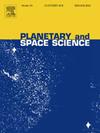Comparison of Kelvin–Helmholtz waves observed simultaneously at the dawn and dusk flanks of the Earth’s magnetopause
IF 1.7
4区 物理与天体物理
Q3 ASTRONOMY & ASTROPHYSICS
引用次数: 0
Abstract
Across the Earth’s magnetopause, unless the magnetic fields stabilise the boundary, the velocity shear between the magnetospheric plasma and the shocked plasma of the solar wind can lead to the Kelvin–Helmholtz instability. This instability can develop into large-scale surface waves and vortices at the magnetopause, causing the different plasma regions to mix, which plays an important role in the transfer of energy across the magnetopause. We know from spacecraft observations and simulations that the way Kelvin–Helmholtz waves grow and evolve can be different at dawn and dusk. However, very few studies have directly observed this phenomenon on both flanks of the magnetopause simultaneously, nor have they provided a consistent explanation for the question of symmetrical or asymmetrical dawn–dusk growth of the waves. By combining measurements from the THEMIS and Cluster missions, we can report here on an event where such a simultaneous observation of the Kelvin–Helmholtz waves is possible.
For this event, we investigate and compare the typical wave parameters and the plasma mixing on the two flanks. Our results suggest an asymmetric evolution of the Kelvin–Helmholtz waves at dawn and dusk. Comparing these results with previous studies of simultaneously observed events and linking them to solar wind conditions further shows that this asymmetric growth seems to occur during the Parker spiral IMF, but probably only if the magnetic fields are strong enough to effectively stabilise the boundary at the dusk flank due to field line draping.

在地球磁层顶的黎明和黄昏两侧同时观测到的开尔文-亥姆霍兹波的比较
在地球磁层顶,除非磁场稳定边界,否则磁层等离子体和太阳风的激波等离子体之间的速度剪切会导致开尔文-亥姆霍兹不稳定性。这种不稳定性可以在磁层顶发展成大规模的表面波和涡旋,导致不同的等离子体区域混合,这在磁层顶的能量传递中起着重要作用。我们从宇宙飞船的观测和模拟中得知,开尔文-亥姆霍兹波在黎明和黄昏时的生长和演化方式可能不同。然而,很少有研究同时在磁层顶两侧直接观察到这种现象,也没有对波的对称或不对称的黎明-黄昏增长问题提供一致的解释。通过结合THEMIS和Cluster任务的测量,我们可以在这里报告一个事件,在这个事件中,开尔文-亥姆霍兹波的同时观测是可能的。对于这一事件,我们研究并比较了典型的波参数和等离子体在两侧的混合。我们的结果表明开尔文-亥姆霍兹波在黎明和黄昏时的演化是不对称的。将这些结果与之前同时观测到的事件的研究结果进行比较,并将它们与太阳风条件联系起来,进一步表明,这种不对称增长似乎发生在帕克螺旋IMF期间,但可能只有当磁场足够强大,能够有效地稳定黄昏侧翼的边界时,因为磁场线下垂。
本文章由计算机程序翻译,如有差异,请以英文原文为准。
求助全文
约1分钟内获得全文
求助全文
来源期刊

Planetary and Space Science
地学天文-天文与天体物理
CiteScore
5.40
自引率
4.20%
发文量
126
审稿时长
15 weeks
期刊介绍:
Planetary and Space Science publishes original articles as well as short communications (letters). Ground-based and space-borne instrumentation and laboratory simulation of solar system processes are included. The following fields of planetary and solar system research are covered:
• Celestial mechanics, including dynamical evolution of the solar system, gravitational captures and resonances, relativistic effects, tracking and dynamics
• Cosmochemistry and origin, including all aspects of the formation and initial physical and chemical evolution of the solar system
• Terrestrial planets and satellites, including the physics of the interiors, geology and morphology of the surfaces, tectonics, mineralogy and dating
• Outer planets and satellites, including formation and evolution, remote sensing at all wavelengths and in situ measurements
• Planetary atmospheres, including formation and evolution, circulation and meteorology, boundary layers, remote sensing and laboratory simulation
• Planetary magnetospheres and ionospheres, including origin of magnetic fields, magnetospheric plasma and radiation belts, and their interaction with the sun, the solar wind and satellites
• Small bodies, dust and rings, including asteroids, comets and zodiacal light and their interaction with the solar radiation and the solar wind
• Exobiology, including origin of life, detection of planetary ecosystems and pre-biological phenomena in the solar system and laboratory simulations
• Extrasolar systems, including the detection and/or the detectability of exoplanets and planetary systems, their formation and evolution, the physical and chemical properties of the exoplanets
• History of planetary and space research
 求助内容:
求助内容: 应助结果提醒方式:
应助结果提醒方式:


